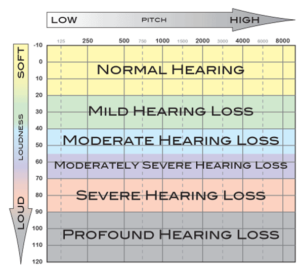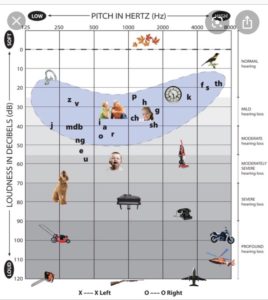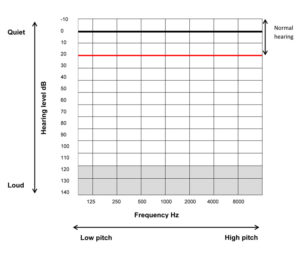What Does my Audiogram Mean?
In Canada, 19% of our 35 million population have hearing loss (Statistics Canada, 2013), and many more than that have their hearing tested regularly. So what does the audiogram mean? What information does it give me about my hearing? Well, here’s a short explanation for you and what your audiogram means.
 What is an Audiogram?
What is an Audiogram?
An audiogram is a graph used in audiology to plot your hearing levels. On this graph, you’ll see the vertical line we call decibels (dB) and the horizontal line for frequency (hertz – Hz). Decibels are the units of volume or loudness used in audiology. Quiet sounds are at the top of the graph and as you go down the louder the sound is. Frequency is the pitch of the sound with low pitch on the left and high pitch on the right. We examine several frequencies from 250 to 8,000 hertz; this captures all the sounds in human speech and more.
During a hearing test, we use this graph to chart how you respond to beeps at each frequency as we raise and lower the volume. Each ear is given a symbol, O for your right ear and X for your left. We’ll look at these more in the next section.
Information is on the Audiogram?
After the hearing test is done, there are several important things to look at. First, we look at the responses of your right and left ear. Depending on where they fall on the graph determines what we call your ‘degree of hearing.’ The degree gives us indicators of what you are and aren’t hearing. Anything below 25 dB we consider to be hearing loss or outside of the normal range. For some people this may only be one or two frequencies, for others, it can be more.

Normal hearing: -10dB to 25dB
Mild Hearing Loss: 25dB to 45dB
Moderate: 45dB to 55dB
Moderately Severe: 55dB to 70dB
Severe: 70dB to 90dB
Profound: 90dB to 120dB
Some other tests can also be included on the audiogram. These may include testing your speech recognition or how well you hear speech presented to you at various volumes, the movement and reflex of your eardrum, and the volumes that you find the most comfortable and the loudest volume you can tolerate. All these can be plotted on the graph itself or in other designated part of our sheet. These provide more specific information on the best recommendations for treatment options for your hearing loss.
What Does it All Mean?
 When we look at all the information on the audiogram, the main agenda is to determine what that means for your hearing in everyday life situations. All of those points we plot on the audiogram for your left and right ears shows us what you might be missing. The graft on the right shows what we call the ‘speech banana;’ it’s a diagram for where all the speech sounds in the English language and other everyday sounds fall on the audiogram.
When we look at all the information on the audiogram, the main agenda is to determine what that means for your hearing in everyday life situations. All of those points we plot on the audiogram for your left and right ears shows us what you might be missing. The graft on the right shows what we call the ‘speech banana;’ it’s a diagram for where all the speech sounds in the English language and other everyday sounds fall on the audiogram.
So, looking at your audiogram and the speech banana, if you have a moderate hearing loss (your hearing levels average around 45 to 55dB) you are missing a lot of the high-frequency sounds (p, h, g, ch, k, sh, f, s, th, etc.) as well as other sounds like birds chirping, your faucet dripping, alarm clocks, etc.
Additionally, those other tests, provide us with indicators for the kind or level of hearing aid that would benefit you the most; i.e. the technology power that would provide you with the best outcomes.
Moving Forward with this Information
For some people, a hearing test is a way to regularly check on their hearing health and provide them with information on how they might need to adjust their communication styles depending on the outcomes of the test. For others, it’s a prescription of what is needed to help them hear optimally with assistance through devices like hearing aids. Regardless of the outcome of your hearing test, your practitioner will walk you through what it all means. Our biggest consideration is how you are feeling and if you have any concerns that need to be addressed regarding your hearing health.
We hope this was a helpful look into what your audiogram means. To book an appointment give us a calls at 705-749-0707. For another great explanation of the audiogram, check out this video by Pacific Northwest Audiology.
 What is an Audiogram?
What is an Audiogram?


Recent Comments